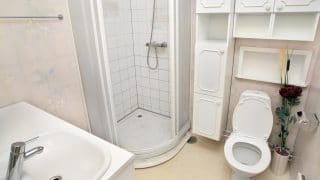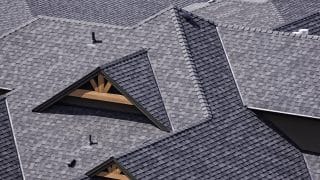
A ledger board is the most critical part of an attached deck—it’s what fastens the deck frame to the house or other building, after all. A poorly installed ledger board risks the integrity and safety of the whole deck. For successful deck construction, it’s worth learning a bit more about ledger boards and how they’re installed.
What is a ledger board?
Attached decks, or ledger decks, are fastened to a building’s wall using a piece of naturally decay-resistant lumber, pressure-treated dimensional lumber, or engineered lumber known as a ledger board; often simply referred to as a “ledger.” It’s usually bolted or screwed to the structural framing inside the adjoining building. The deck joists are attached to the exposed face of the ledger board using metal joist hangers.
The ledger board transfers roughly half of the weight of the deck and the live load on the deck to the framing of the adjoining building that is supported by the building’s foundation. The other half of the deck loads are supported by a beam, posts, and footings along the outside edge of the deck. If a deck ledger fails to adequately support its share of the deck loads the deck can collapse. The two main reasons for structural weakness and deck collapses are improper fastening and water damage to the house structure that the ledger is attached to.
Freestanding decks, as the name implies, are self-supporting. The weight of the deck and the live load are borne by its beams, posts, and footings, so there’s no need for a ledger board. The choice between the freestanding or attached deck style is informed by factors such as suitability of the adjoining building to support a deck ledger, location of the deck, and builder preference.
Choosing the right ledger board for a deck
An attached deck is only as good as the ledger board that supports the deck joists, and the ledger board is only as good as its materials. A ledger board must also be able to withstand the elements.
A ledger board is made of pressure-treated or naturally rot-resistant dimensional or engineered lumber. The depth (height) of the ledger board must be equal to or taller than the lumber used for the deck joists—usually this is 2×6 or larger. The board should ideally be straight, with as few defects as possible like an excessive number of knots and splits.
Attaching a deck ledger board
The ledger board must be fastened to the adjoining building’s lumber frame. The most common part of the building’s frame that a ledger is attached to is the rim joist (also called the “band joist,” “band board” or “rim board”). The ledger can also be fastened to the building’s wall studs, wall plates, mudsill and/or directly to the foundation.
The International Residential Code (IRC) prescribes two generic fasteners for attaching a deck ledger to the rim joist of the adjoining building: 1/2 inch diameter hot-dipped galvanized (HDG) lag screws and 1/2 inch diameter hex-head HDG machine bolts along with 1/2 inch HDG washers under the heads and nuts of each fastener to distribute the load over a broader surface area.
Note: A common type of bolt referred to as a “Carriage bolt” is not recognized by the IRC and is not equal in strength to hex-head bolts so should never be used to fasten a deck ledger to a house. Carriage bolts have a cap style head with a square portion of the shank under the cap.
The IRC has a deck ledger fastening table that outlines how far lag screws and hex-head bolts can be spaced apart along the ledger based on the span of the deck joists from the ledger to the beam along the outside. Figures in the IRC illustrate where the lag screws or hex-head bolts are located on the face of the ledger and through the rim joist. The fasteners need to be placed in two rows along the length of the ledger in a ‘W’ pattern with minimum and maximum distances between the ledger and rim joist edges.
The IRC and engineering standards that the IRC is based on include other general notes about proper fastener installation, including:
- Minimum requirements for the rim joist material;
- Maximum distance between the face of the rim joist and the back face of the deck ledger (1 inch);
- Fasteners that fall where a deck joist or in the field of a joist hanger flange may be moved up to 3 inches left or right to avoid the interference;
- Fasteners cannot be countersunk below the surface of the deck ledger or rim joist;
- The inside face of the rim joist must be accessible for the building inspector to view and verify proper attachment.
The IRC-prescribed fasteners aren’t the only way you can attach the ledger to the adjoining structure. Proprietary screws and specialty deck ledger fastening systems can also be used—provided the local building department approves. These screws and fastening systems can simplify ledger installation and solve challenging installation situations.
7 ways to attach ledger boards
1. Using lag screws.
Two holes need to be drilled to prepare the ledger board and the rim joist to receive each lag screw. A clearance hole with a minimum diameter of 17/32 inch to a maximum of 9/16 inch is drilled through the ledger board to clear a pathway for the shank of the lag screw.
A pilot hole is drilled through the rim joist that closely matches the root diameter of the threaded portion of the lag screw. Acceptable pilot hole diameters are between 5/16 inch and 3/8 inch. The tips of the lag screws should penetrate beyond the inside face of the rim joist by at least 1/2 inch for the building inspector to verify proper installation and lag screw length.
2. Using hex-head bolts.
A minimum diameter of 17/32 inch to a maximum of 9/16 inch clearance hole is drilled through the ledger board and the rim joist. The bolts must be long enough so at least 2 or 3 threads extend past the nut on the inside.
3. Spacing the deck ledger off of the face of the wall.
The IRC deck ledger fastener spacing table lists a section for spacing the ledger off of the face of the sheathing. This method eliminates the need for flashing on top of the ledger.
A waterproof layer is applied over the surface of the wall, behind deck ledger location. The layer is tucked behind the siding above the ledger and over the siding below the ledger so the cladding surface is continuous and sheds water. Water drains freely and dries in the air space between the back of the deck ledger and the wall.
Hex-head bolts are used as fasteners and the spacers can be a stack of washers or other material approved by the local building official. The maximum distance between the face of the rim joist and the back face of the deck ledger cannot exceed 1 inch using the IRC spacing table. The 1 inch distance can be made up of 1/2 inch thick wall sheathing and a 1/2 inch air space or other thickness combinations—thinner sheathing and wider air space or thicker sheathing and narrower air space.
4. Securing a deck ledger to a concrete foundation.
The deck ledger can be fastened to the adjacent structure’s foundation instead of the framing. This allows the surface of the deck to be set one or more step heights below the floor level inside the house, which may be desirable in snowy or wet climates.
A ledger board is the most critical part of an attached deck—it’s what fastens the deck frame to the house or other building, after all. A poorly installed ledger board risks the integrity and safety of the whole deck. For successful deck construction, it’s worth learning a bit more about ledger boards and how they’re installed.
What is a ledger board?
Attached decks, or ledger decks, are fastened to a building’s wall using a piece of naturally decay-resistant lumber, pressure-treated dimensional lumber, or engineered lumber known as a ledger board; often simply referred to as a “ledger.” It’s usually bolted or screwed to the structural framing inside the adjoining building. The deck joists are attached to the exposed face of the ledger board using metal joist hangers.
The ledger board transfers roughly half of the weight of the deck and the live load on the deck to the framing of the adjoining building that is supported by the building’s foundation. The other half of the deck loads are supported by a beam, posts, and footings along the outside edge of the deck. If a deck ledger fails to adequately support its share of the deck loads the deck can collapse. The two main reasons for structural weakness and deck collapses are improper fastening and water damage to the house structure that the ledger is attached to.
Freestanding decks, as the name implies, are self-supporting. The weight of the deck and the live load are borne by its beams, posts, and footings, so there’s no need for a ledger board. The choice between the freestanding or attached deck style is informed by factors such as suitability of the adjoining building to support a deck ledger, location of the deck, and builder preference.
Choosing the right ledger board for a deck
An attached deck is only as good as the ledger board that supports the deck joists, and the ledger board is only as good as its materials. A ledger board must also be able to withstand the elements.
A ledger board is made of pressure-treated or naturally rot-resistant dimensional or engineered lumber. The depth (height) of the ledger board must be equal to or taller than the lumber used for the deck joists—usually this is 2×6 or larger. The board should ideally be straight, with as few defects as possible like an excessive number of knots and splits.
Attaching a deck ledger board
The ledger board must be fastened to the adjoining building’s lumber frame. The most common part of the building’s frame that a ledger is attached to is the rim joist (also called the “band joist,” “band board” or “rim board”). The ledger can also be fastened to the building’s wall studs, wall plates, mudsill and/or directly to the foundation.
The International Residential Code (IRC) prescribes two generic fasteners for attaching a deck ledger to the rim joist of the adjoining building: 1/2 inch diameter hot-dipped galvanized (HDG) lag screws and 1/2 inch diameter hex-head HDG machine bolts along with 1/2 inch HDG washers under the heads and nuts of each fastener to distribute the load over a broader surface area.
Note: A common type of bolt referred to as a “Carriage bolt” is not recognized by the IRC and is not equal in strength to hex-head bolts so should never be used to fasten a deck ledger to a house. Carriage bolts have a cap style head with a square portion of the shank under the cap.
The IRC has a deck ledger fastening table that outlines how far lag screws and hex-head bolts can be spaced apart along the ledger based on the span of the deck joists from the ledger to the beam along the outside. Figures in the IRC illustrate where the lag screws or hex-head bolts are located on the face of the ledger and through the rim joist. The fasteners need to be placed in two rows along the length of the ledger in a ‘W’ pattern with minimum and maximum distances between the ledger and rim joist edges.
The IRC and engineering standards that the IRC is based on include other general notes about proper fastener installation, including:
- Minimum requirements for the rim joist material;
- Maximum distance between the face of the rim joist and the back face of the deck ledger (1 inch);
- Fasteners that fall where a deck joist or in the field of a joist hanger flange may be moved up to 3 inches left or right to avoid the interference;
- Fasteners cannot be countersunk below the surface of the deck ledger or rim joist;
- The inside face of the rim joist must be accessible for the building inspector to view and verify proper attachment.
The IRC-prescribed fasteners aren’t the only way you can attach the ledger to the adjoining structure. Proprietary screws and specialty deck ledger fastening systems can also be used—provided the local building department approves. These screws and fastening systems can simplify ledger installation and solve challenging installation situations.
7 ways to attach ledger boards
1. Using lag screws.
Two holes need to be drilled to prepare the ledger board and the rim joist to receive each lag screw. A clearance hole with a minimum diameter of 17/32 inch to a maximum of 9/16 inch is drilled through the ledger board to clear a pathway for the shank of the lag screw.
A pilot hole is drilled through the rim joist that closely matches the root diameter of the threaded portion of the lag screw. Acceptable pilot hole diameters are between 5/16 inch and 3/8 inch. The tips of the lag screws should penetrate beyond the inside face of the rim joist by at least 1/2 inch for the building inspector to verify proper installation and lag screw length.
2. Using hex-head bolts.
A minimum diameter of 17/32 inch to a maximum of 9/16 inch clearance hole is drilled through the ledger board and the rim joist. The bolts must be long enough so at least 2 or 3 threads extend past the nut on the inside.
3. Spacing the deck ledger off of the face of the wall.
The IRC deck ledger fastener spacing table lists a section for spacing the ledger off of the face of the sheathing. This method eliminates the need for flashing on top of the ledger.
A waterproof layer is applied over the surface of the wall, behind deck ledger location. The layer is tucked behind the siding above the ledger and over the siding below the ledger so the cladding surface is continuous and sheds water. Water drains freely and dries in the air space between the back of the deck ledger and the wall.
Hex-head bolts are used as fasteners and the spacers can be a stack of washers or other material approved by the local building official. The maximum distance between the face of the rim joist and the back face of the deck ledger cannot exceed 1 inch using the IRC spacing table. The 1 inch distance can be made up of 1/2 inch thick wall sheathing and a 1/2 inch air space or other thickness combinations—thinner sheathing and wider air space or thicker sheathing and narrower air space.
4. Securing a deck ledger to a concrete foundation.
The deck ledger can be fastened to the adjacent structure’s foundation instead of the framing. This allows the surface of the deck to be set one or more step heights below the floor level inside the house, which may be desirable in snowy or wet climates.
HDG or stainless steel expansion anchors (also called ‘wedge anchors‘), stainless steel concrete screw anchors, or adhesive anchoring systems can be used to fasten the deck ledger. The IRC does not have prescriptive spacing for the fasteners so follow the anchor manufacturers’ installation instructions and verify the local building official will permit their use.
5. Securing a deck ledger to a concrete block (CMU) foundation.
Concrete blocks have hollow cavities. When the cavities have been filled with concrete (a process referred to as “grouting”), you can use the same anchors as a poured concrete foundation to install a ledger. When the cavities are hollow the ledger fastening approaches become limited.
The simplest method is to use a screen-grid adhesive anchor system. HDG or stainless steel rods are secured to the hollow block walls by blobs of epoxy or acrylic adhesive that are injected into wire or plastic retainers inserted into drill holes. Check with the anchor manufacturers’ instructions for specific deck ledger installation details and anchor spacing.
6. Using proprietary structural screws.
Several structural screw manufacturers have designed screws for mounting deck ledgers to the framing of adjacent structures. The screws are easy to install with a drill-driver and usually don’t require the pilot holes that lag screw installation does. Each manufacturer has specific installation instructions and fastener spacing tables unique to each screw. Fastener spacing tables and instructions for one manufacturer’s screws cannot be used with another brand of screw since each of the screws has a different design capacity.
Some screw manufacturers provide installation instructions for fastening deck ledgers to wall studs, wall plates, and mudsills—something that cannot be done with lag screws or hex-head bolts.
Each manufacturer usually covers special conditions in their instructions. For example: Some manufacturers prohibit the use of impact drivers to install their screws. Also, the screw tips must penetrate a minimum amount into or through dimensional or engineered lumber to meet the allowable deck and live loads, and for the local building inspector to view and verify proper installation.
7. Using proprietary deck ledger mounting brackets.
There are several specialty deck ledger mounting systems designed to solve ledger installation challenges. Deck ledgers cannot be fastened to veneer brick, stone cladding, adhered stone, synthetic stone cladding, walls with thick exterior insulation, or in cases where an air space greater than 1/2 inch is called for. These mounting systems enable the deck ledger to be spaced between 3 inches and 6-3/4 inches off a building’s wall surface.
Some are designed for new construction situations and others are designed for retrofit deck ledger installations. Carefully follow the manufacturer’s installation instructions, and obtain approval from the local building official before using an alternative ledger installation method before installing one.
Flashing a deck ledger board
Flashing prevents water from leaking below or behind the cladding or deck ledger. It can be one material or a combination of materials. The IRC requires that deck ledgers have a flashing system installed above and below to prevent water from entering wall cavities or reaching the framing of the adjoining structure.
The IRC requires metal flashing that is corrosion-resistant and at least 0.019 inch / 26 gauge thick. Other materials may be used like PVC or other plastic, or self-adhering membrane flashing—provided they comply with the IRC requirements and/or are approved for use by the local building official.
Flashing is shaped like an L or a Z with a wall leg that is tall enough to be covered by the water-resistive barrier and by the siding that’s above the top of the decking surface.
The ledger flashing wall leg height or counterflashing height will need to be at least 5 inches (and, in some cases, up to 8 inches tall) to meet the siding clearance requirements. The cap leg of the flashing needs to cover the top of the deck ledger and either extend in an L fashion out over the top of the deck joists by 3 inches or turn down the face of the ledger in a Z fashion by 1/2 inch. This design prevents water from reaching the top of the ledger and leaking back to the wall.
When the adjacent structures’ wood framing is below the bottom of the deck ledger, a second flashing needs to be installed behind and below the ledger, as well as on top of the surface of the wall cladding. This is arguably the most important step, as water leaking in behind the ledger board can lead to rot and decay in the adjacent building’s framing—which could lead to it failing to support the deck ledger and the deck collapsing.
MT Copeland offers video-based online classes that give you a foundation in construction fundamentals with real-world applications, like how to build a freestanding deck.
Classes include professionally produced videos taught by practicing craftspeople, and supplementary downloads like quizzes, blueprints, and other materials to help you master the skills.







